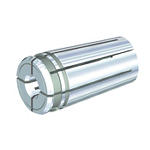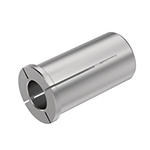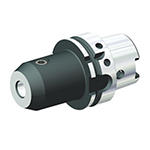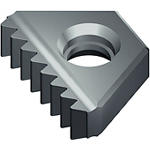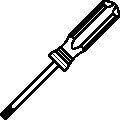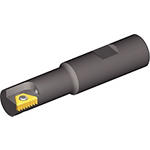Product Similar To:
TMS • Thread Milling System • Thread Mills • Normal
Indexable Thread Mills
Material Number1130686
ISO Catalog ID17X1R022B16STN16NANSI Catalog ID17X1R022B16STN16N
- P Steel
- M Stainless Steel
- K Cast Iron
- S High-Temp Alloys
- H Hardened Materials
Sending to {{cadTool}} in progress...
Downloaded file will be available after import in the {{cadTool}} tool library.
- Overview
- Application Data
- Downloads
- Compatible Parts Machine Side
- Compatible Parts Workpiece Side
- Spare Parts
- Reviews
- Q&A
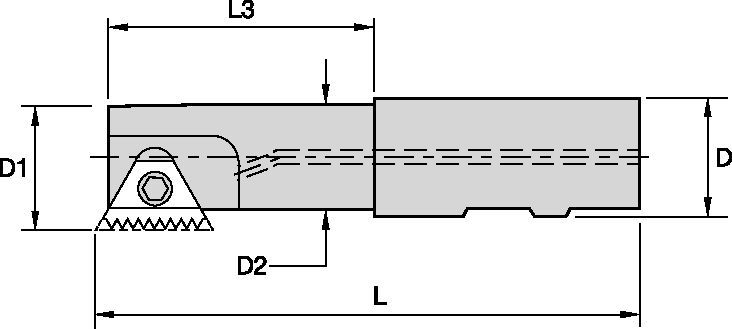
| Material Number | 1130686 |
| ISO Catalog ID | 17X1R022B16STN16N |
| ANSI Catalog ID | 17X1R022B16STN16N |
| [D1] Effective Cutting Diameter | 17 mm |
| [D1] Effective Cutting Diameter | 0.6692 in |
| [D] Adapter / Shank / Bore Diameter | 16 mm |
| [D] Adapter / Shank / Bore Diameter | 0.6299 in |
| [D2] Maximum Body Diameter | 13.6 mm |
| [D2] Maximum Body Diameter | 0.5354 in |
| [L] Overall Length | 90 mm |
| [L] Overall Length | 3.5433 in |
| [L3] Usable Length | 22 mm |
| [L3] Usable Length | 0.866 in |
| Number of Inserts | 1 |
| Max RPM | 25750 |
| Gage Insert | STN16 |
Workpiece Materials
- Steel
- Stainless Steel
- Cast Iron
- High-Temp Alloys
- Hardened Materials
Features and benefits
- For internal and external threading on most types of workpiece materials.
- One tool is used for both right- and left-hand threads.
- All cutters have through-coolant capability.
- Utilizes inserts with various profiles and pitches.
Create Solution to calculate Feeds and Speeds
After creating a solution just choose the Feeds & Speeds icon and our system will provide recommendations. You can customize the information by adding your machine and specifications or make adjustments using the sliders.
Application Data
 | 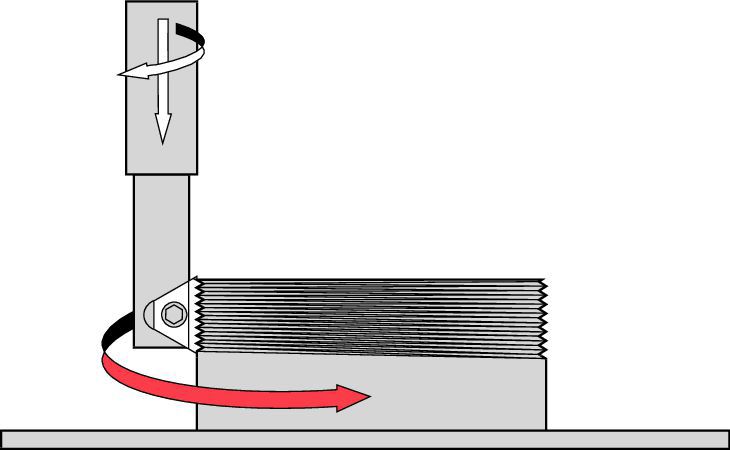 |
| right-hand thread... conventional milling | left-hand thread... conventional milling |
 | 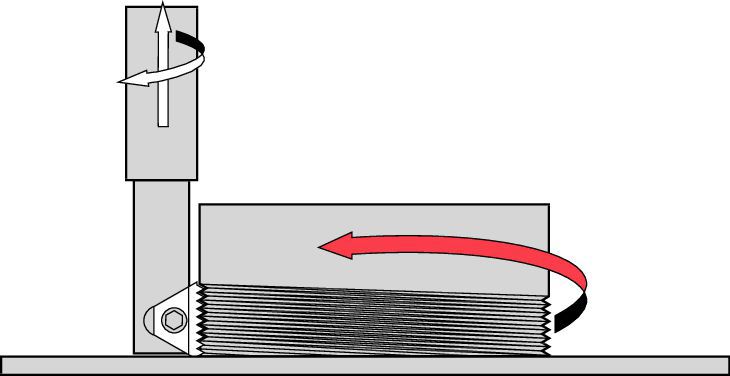 |
| right-hand thread... climb milling | left-hand thread... climb milling |
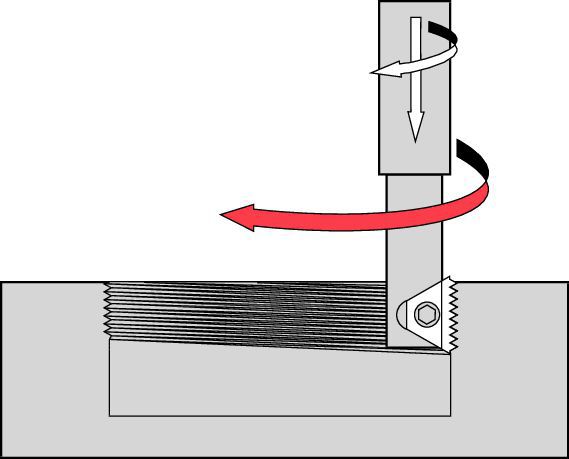 | 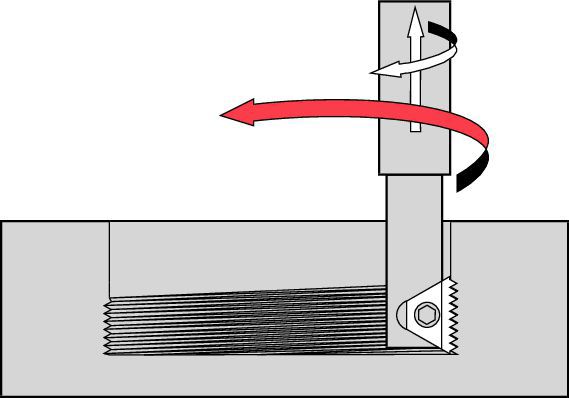 |
| right-hand thread... conventional milling | left-hand thread... conventional milling |
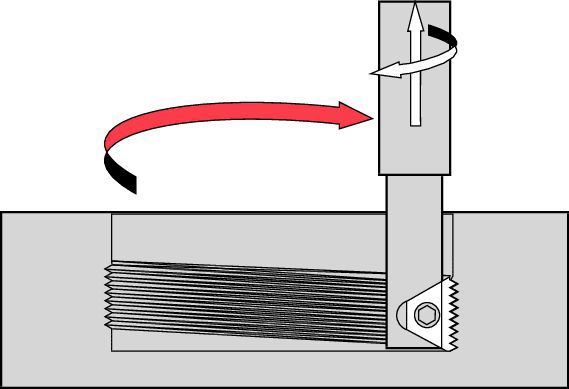 | 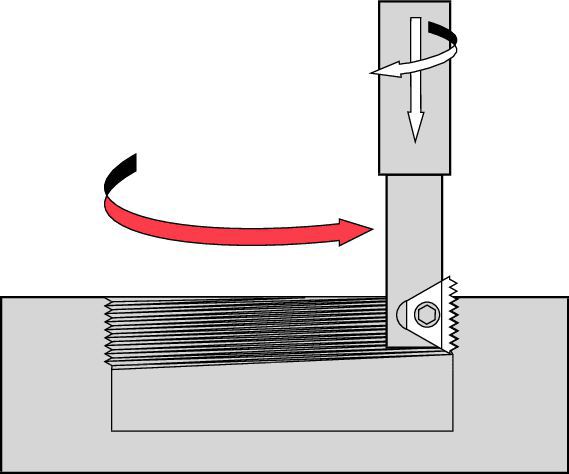 |
| right-hand thread... climb milling | left-hand thread... climb milling |
| cutter | TPI | 48 | 32 | 24 | 20 | 16 | 12 | 10 | 8 | 7 | 6 | 5.5 | 5 | 4.5 | 4.5 | 4 | 4 |
| pitch mm | 0,5 | 0,75 | 1,0 | 1,25 | 1,5 | 2,0 | 2,5 | 3,0 | 3,5 | 4,0 | 4,5 | 5,0 | 5,5 | – | 6,0 | – | |
| cutter diameter (D1) | minimum bore diameter (D) (inches) | ||||||||||||||||
| K035TM1RW050-STN10 | .35 | .374 | .394 | .421 | .449 | ||||||||||||
| K045TM1RW050-STN11N | .45 | .472 | .492 | .520 | .547 | .571 | |||||||||||
| K049TM1RW037LT11S | .49 | .512 | .531 | .559 | .587 | .610 | |||||||||||
| K061TM1RW062-STN16T | .61 | .630 | .650 | .667 | .705 | .728 | .768 | ||||||||||
| K067TM2RW075-STN11D | .67 | .693 | .717 | .748 | .772 | .787 | .827 | ||||||||||
| K075TM1RW075-STN16T | .75 | .776 | .803 | .827 | .850 | .866 | .906 | ||||||||||
| K079TM1RW075-STN16N | .79 | .815 | .843 | .866 | .890 | .906 | .945 | ||||||||||
| K087TM1RW100-STN16L | .87 | .893 | .921 | .945 | .969 | .984 | 1.024 | ||||||||||
| K102TM2RW100-STN16D | 1.02 | 1.051 | 1.079 | 1.102 | 1.130 | 1.154 | 1.193 | ||||||||||
| K118TM1RW100-STN27N | 1.18 | 1.209 | 1.236 | 1.260 | 1.291 | 1.319 | 1.362 | 1.441 | 1.535 | 1.654 | 1.772 | 1.890 | |||||
| K146TM1RW125-STN27N | 1.46 | 1.496 | 1.520 | 1.555 | 1.591 | 1.614 | 1.654 | 1.732 | 1.830 | 1.929 | 2.047 | 2.185 | |||||
| K165TM2RW125-STN27D | 1.65 | 1.701 | 1.724 | 1.772 | 1.811 | 1.831 | 1.866 | 1.929 | 2.047 | 2.146 | 2.268 | 2.401 | |||||
| – | 1.38 (UN) | – | – | – | – | – | – | – | – | – | 1.969 | – | 1.843 | – | 1.756 | – | 2.228 |
| – | 1.38 (ISO) | – | – | – | – | – | – | – | – | – | 1.969 | 2.102 | 1.673 | 1.969 | – | 2.264 | – |
| – | 1.38 (BSW) | – | – | – | – | – | – | – | – | – | 1.961 | – | 1.831 | – | 1.866 | – | – |
| cutter | TPI | 48 | 32 | 24 | 20 | 16 | 12 | 10 | 8 | 7 | 6 | 5.5 | 5 | 4.5 | 4.5 | 4 | 4 |
| pitch mm | 0,5 | 0,75 | 1,0 | 1,25 | 1,5 | 2,0 | 2,5 | 3,0 | 3,5 | 4,0 | 4,5 | 5,0 | 5,5 | – | 6,0 | – | |
| cutter diameter (D1 mm) | minimum bore diameter (D) (mm) | ||||||||||||||||
| K035TM1RW050-STN10 | 8,89 | 9,50 | 10,01 | 10,69 | 11,40 | ||||||||||||
| K045TM1RW050-STN11N | 11,43 | 11,99 | 12,50 | 13,21 | 13,89 | 14,50 | |||||||||||
| K049TM1RW037LT11S | 12,45 | 13,00 | 13,49 | 14,20 | 14,91 | 15,49 | |||||||||||
| K061TM1RW062-STN16T | 15,49 | 16,00 | 16,51 | 16,94 | 17,91 | 18,49 | 19,51 | ||||||||||
| K067TM2RW075-STN11D | 17,02 | 17,60 | 18,21 | 19,00 | 19,61 | 19,99 | 21,01 | ||||||||||
| K075TM1RW075-STN16T | 19,05 | 19,71 | 20,40 | 21,01 | 21,59 | 22,00 | 23,01 | ||||||||||
| K079TM1RW075-STN16N | 20,07 | 20,70 | 21,41 | 22,00 | 22,61 | 23,01 | 24,00 | ||||||||||
| K087TM1RW100-STN16L | 22,10 | 22,68 | 23,39 | 24,00 | 24,61 | 24,99 | 26,01 | ||||||||||
| K102TM2RW100-STN16D | 25,91 | 26,70 | 27,41 | 27,99 | 28,70 | 29,31 | 30,30 | ||||||||||
| K118TM1RW100-STN27N | 29,97 | 30,71 | 31,39 | 32,00 | 32,79 | 33,50 | 34,59 | 36,60 | 38,99 | 42,01 | 45,01 | 48,01 | |||||
| K146TM1RW125-STN27N | 37,08 | 38,00 | 38,61 | 39,50 | 40,41 | 41,00 | 42,01 | 43,99 | 46,48 | 49,00 | 51,99 | 55,50 | |||||
| K165TM2RW125-STN27D | 41,91 | 43,21 | 43,79 | 45,01 | 46,00 | 46,51 | 47,40 | 49,00 | 51,99 | 54,51 | 57,61 | 60,99 | |||||
| – | 35,05 (UN) | – | – | – | – | – | – | – | – | – | 50,01 | – | 46,81 | – | 44,60 | – | 56,59 |
| – | 35,05 (ISO) | – | – | – | – | – | – | – | – | – | 50,01 | 53,39 | 42,49 | 50,01 | – | 57,51 | – |
| – | 35,05 (BSW) | – | – | – | – | – | – | – | – | – | 49,81 | – | 46,51 | – | 47,40 | – | – |
| workpiece material | Cutting Speed | feed rate per revolution (mm) |
| KC635M | ||
| carbon steels 187 HB | 90–210 | 0,10–0,20 |
| carbon steels 187–220 HB | 90–150 | 0,10–0,15 |
| alloy steel 200–250 HB | 60–130 | 0,10–0,15 |
| alloy steel 250–325 HB | 50–90 | 0,10–0,15 |
| stainless steel, austenitic 210 HB | 90–140 | 0,10–0,15 |
| stainless steel, martensitic 321 HB | 80–110 | 0,05–0,15 |
| stainless steel, ferritic 245 HB | 110–170 | 0,05–0,10 |
| cast steel 140 HB | 110–170 | 0,05–0,15 |
| cast steel 220 | 70–130 | 0,05–0,10 |
| titanium alloys | 60–120 | 0,03–0,08 |
| high-temperature (nickel and iron base) | 20–45 | 0,03–0,05 |
| high-temperature (cobalt base) | 15–30 | 0,03–0,05 |
| cast iron | 80–110 | 0,05–0,15 |
| malleable iron | 80–120 | 0,03–0,08 |
| workpiece material | Cutting Speed | feed rate per revolution (inch) |
| KC635M | ||
| carbon steels 187 HB | 300–700 | .004–.008 |
| carbon steels 187–220 HB | 300–500 | .004–.006 |
| alloy steel 200–250 HB | 200–425 | .004–.006 |
| alloy steel 250–325 HB | 150–300 | .004–.006 |
| stainless steel, austenitic 210 HB | 300–450 | .004–.006 |
| stainless steel, martensitic 321 HB | 250–350 | .002–.006 |
| stainless steel, ferritic 245 HB | 350–550 | .002–.004 |
| cast steel 140 HB | 350–550 | .002–.006 |
| cast steel 220 | 225–425 | .002–.004 |
| titanium alloys | 200–400 | .001–.003 |
| high-temperature (nickel and iron base) | 75–150 | .001–.002 |
| high-temperature (cobalt base) | 50–100 | .001–.002 |
| cast iron | 250–350 | .002–.006 |
| malleable iron | 250–400 | .001–.003 |
| 1–2: | radial entry |
| 2–3: | helical movement during one full orbit (360°) |
| 3–4: | radial exit |
| P1 = F1 + | (F1 x d1) | 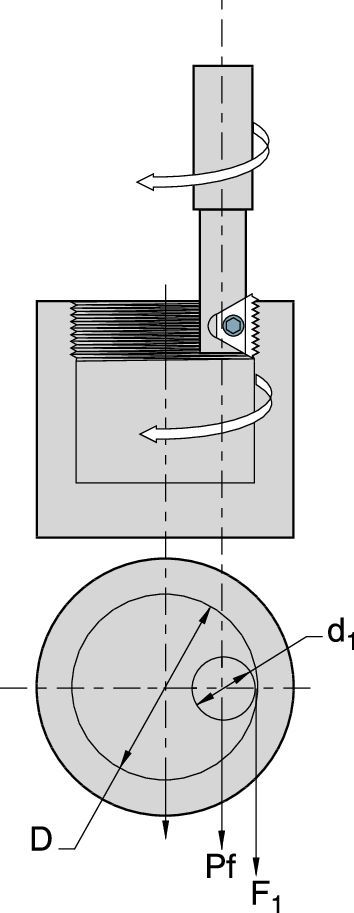 |  |
| D | external thread | internal thread | |
| P1 = program feed rate (in/min) D= major diameter (external thread) D= minor diameter (internal thread) d1 = cutting diameter, over insert | tool workpiece | ||
| F1 = fz x Z x n | RPM = | 12 x SFM | |
| π x d 1 | |||
| F1 =tool feed rate at the cutting edge (in/min) fz=inch per tooth (feed rate) Z=number of effective inserts in cutter n=rotational speed (spindle RPM) | SFM=cutting speed, surface feet per minute d1 =cutter diameter, over insert π=3.1416 | ||
 |  |
| internal thread | external thread |
| pitch (TPI) | 24 | 20 | 16 | 12 |
| pitch mm | 1,0 | 1,25 | 1,5 | 2,0 |
| cutter dia. d1 | minimum bore diameter D | |||
| .67 | .748 | .772 | .787 | .827 |
| .75 | .827 | .850 | .866 | .906 |
| .79 | .866 | .890 | .906 | .945 |
| insert IC | a (mm) | pitch (TPI) | internal thread | b | number of teeth | grade | external thread | b | number of teeth | grade | cutter type | ||
| catalog number | KC610M | KC620M | catalog number | KC610M | KC620M | ||||||||
| 32 | STN16 32UN-I | 14,99 | 19 | STN16 32UN-E | 14,99 | 19 | |||||||
| 28 | STN16 28UN-I | 14,48 | 16 | STN16 28UN-E | 14,48 | 16 | |||||||
| 27 | STN16 27UN-I | 14,22 | 15 | STN16 27UN-E | 14,22 | 15 | |||||||
| 24 | STN16 24UN-I | 13,97 | 14 | STN16 24UN-E | 14,73 | 14 | |||||||
| 9,53 | 16 | 20 | STN16 20UN-I | 13,97 | 11 | STN16 20UN-E | 13,97 | 11 | STN16 | ||||
| 18 | STN16 18UN-I | 14,22 | 10 | STN16 18UN-E | 14,22 | 10 | |||||||
| 16 | STN16 16UN-I | 14,22 | 9 | STN16 16UN-E | 14,22 | 9 | |||||||
| 14 | STN16 14UN-I | 14,48 | 8 | STN16 14UN-E | 14,48 | 8 | |||||||
| 13 | STN16 13UN-I | 13,72 | 7 | STN16 13UN-E | 13,72 | 7 | |||||||
| 12 | STN16 12UN-I | 14,73 | 7 | STN16 12UN-E | 14,73 | 7 | |||||||
| pitch (TPI) | 24 | 20 | 16 | 12 |
| pitch mm | 1,0 | 1,25 | 1,5 | 2,0 |
| cutter dia. d1 | minimum bore diameter D | |||
| 17,02 | 19,00 | 19,61 | 19,99 | 21,01 |
| 19,05 | 21,01 | 21,59 | 22,00 | 23,01 |
| 20,07 | 22,00 | 22,61 | 23,01 | 24,00 |
| insert IC | a inch (mm) | pitch (TPI) | internal thread | b | number of teeth | grade | external thread | b | number of teeth | grade | cutter type | ||
| catalog number | KC610M | KC620M | catalog number | KC610M | KC620M | ||||||||
| 32 | STN16 32UN-I | .59 | 19 | STN16 32UN-E | .59 | 19 | |||||||
| 28 | STN16 28UN-I | .57 | 16 | STN16 28UN-E | .57 | 16 | |||||||
| 27 | STN16 27UN-I | .56 | 15 | STN16 27UN-E | .56 | 15 | |||||||
| 24 | STN16 24UN-I | .55 | 14 | STN16 24UN-E | .58 | 14 | |||||||
| 3/8 | .63 (16) | 20 | STN16 20UN-I | .55 | 11 | STN16 20UN-E | .55 | 11 | STN16 | ||||
| 18 | STN16 18UN-I | .56 | 10 | STN16 18UN-E | .56 | 10 | |||||||
| 16 | STN16 16UN-I | .56 | 9 | STN16 16UN-E | .56 | 9 | |||||||
| 14 | STN16 14UN-I | .57 | 8 | STN16 14UN-E | .57 | 8 | |||||||
| 13 | STN16 13UN-I | .54 | 7 | STN16 13UN-E | .54 | 7 | |||||||
| 12 | STN16 12UN-I | .58 | 7 | STN16 12UN-E | .58 | 7 | |||||||
| Calculate the feed rates: | |||||
| First, find the RPM. | |||||
| RPM = | 12 x SFM | = | 12 x 500 | = | 2418 RPM |
| π x d1 | 3.14 x .79 | ||||
| Next, calculate the feed rate at the insert cutting edge (F1): | |||||
| (using the chosen feed per tooth of .004.) | |||||
| F1 = | IPT x nt x RPM | = | .004 X 1 X 2418 | = | 9.67 in/min |
| Finally, calculate the feed rate at the cutter centerline (F2): | |||||
| F2 = | F1 x (D - d1) | = | 9.67 x (1.182 - .79) | = | 3.207 in/min |
| D | 1.182 | ||||
| Select the thread milling method. | |||||
| Climb milling (preferred) see page . | |||||
| Calculate the radius of the tangential arc Re: | |||||
| Re = | (Ri - CL)2 + R02 | = | (.591 - .02)2 + .6252 | ||
| 2Ro | 2 x .625 | ||||
| Re = | .573333 in. | ||||
| Calculate the angle (β): | |||||
| β = | 90° + arc sin | Ro - Re | |||
| Re | |||||
| β = | 90° + arc sin | .625 - .573333 | |||
| .57333 | |||||
| β = | 90° + 5.17° | = | 95.17° | = | 95° 10' |
| Calculate the movement along the Z-axis during the entry approach from point “A” to point “B” (Zα). | |||||
| Zα= P (in) x | α° | = | .0625 | = | .0156 in, because α = 90° |
| 360° | 4 | ||||
| Calculate the “X” and “Y” values at the start of the entry approach. | |||||
| X = 0Y = -Ri + CL = -.591 + .02 = - .571 in. | |||||
| Define Z-axis location at the start of the entry approach. (NOTE: L = length of thread) | |||||
| Z = - (L + Zα) = - (.50 + .0156) = - .5156 in. | |||||
| Define the starting point. | |||||
| Xa = 0 | |||||
| Ya = 0 | |||||
| Calculate the feed rates: | |||||
| First, find the RPM. | |||||
| RPM = | 1000 x Vc | = | 1000 x 150 | = | 2387 RPM |
| π x d1 | π x 20 | ||||
| Next, calculate the feed rate at the insert cutting edge (F1): | |||||
| (using the chosen feed per tooth of 0,1mm.) | |||||
| F1 = | Fz x Z x N | = | 0,1 X 1 X 2387 | = | 238,7 mm/min |
| Finally, calculate the feed rate at the cutter centerline (F2): | |||||
| F2 = | F1 x (D - d1) | = | 238,7 x (30 | = | 79,57 mm/min |
| D | 30 | ||||
| Select the thread milling method. | |||||
| Climb milling (preferred) see page . | |||||
| Calculate the radius of the tangential arc Re: | |||||
| Re = | (Ri - CL)2 + RO2 | = | (15 | ||
| 2 x RO | 2 x 15,875 | ||||
| Re = | 14,55mm | ||||
| Calculate the angle (β): | |||||
| β = | 90° + arc sin | Ro - Re | |||
| Re | |||||
| β = | 90° + arc sin | 15,875 - 14,55 | |||
| 14,55 | |||||
| β = | 90° + 5.17° | = | 95,2° | = | 95° 12' |
| Calculate the movement along the Z-axis during the entry approach from point “A” to point “B” (Zα). | |||||
| Zα= P (mm) x | α° | = | 1,578 | = | 0,394mm because α = 90° |
| 360° | 4 | ||||
| Calculate the “X” and “Y” values at the start of the entry approach. | |||||
| X = 0Y = Ri + CL = 15 + 0,5 = 15,5mm | |||||
| Define Z-axis location at the start of the entry approach. (NOTE: L = length of thread) | |||||
| Z = (L + Zα) = 12,7 + 0,3945 = 13,0945mm | |||||
| Define the starting point. | |||||
| Xa = 0 | |||||
| Ya = 0 | |||||
| CNC Program (Fanuc 11M) | |||
| % | |||
| N10G90G00G57X0.000Y0.000 | |||
| N20G43H10Z0.M3S2417 | |||
| N30G91G00X0.Y0.Z–0.5156 | |||
| N40G41D60X0.000Y–0.5710Z0. | |||
| N50G03X0.6250Y0.5710Z0.0156R0.5733F3.206 | |||
| N60G03X0.Y0.Z0.0625I–0.625J0. | |||
| N70G03X–0.625Y0.5710Z0.0156R0.5733 | |||
| N80G00G40X0.Y–0.5710Z0. | |||
| N90G49G57G00Z8.0M5 | |||
| N100M30 | |||
| % | |||
| Ri = | D | Ro= | Do |
| 2 | 2 | ||
| D = minor diameter | Do = nominal diameter | ||
| α 90° | |||
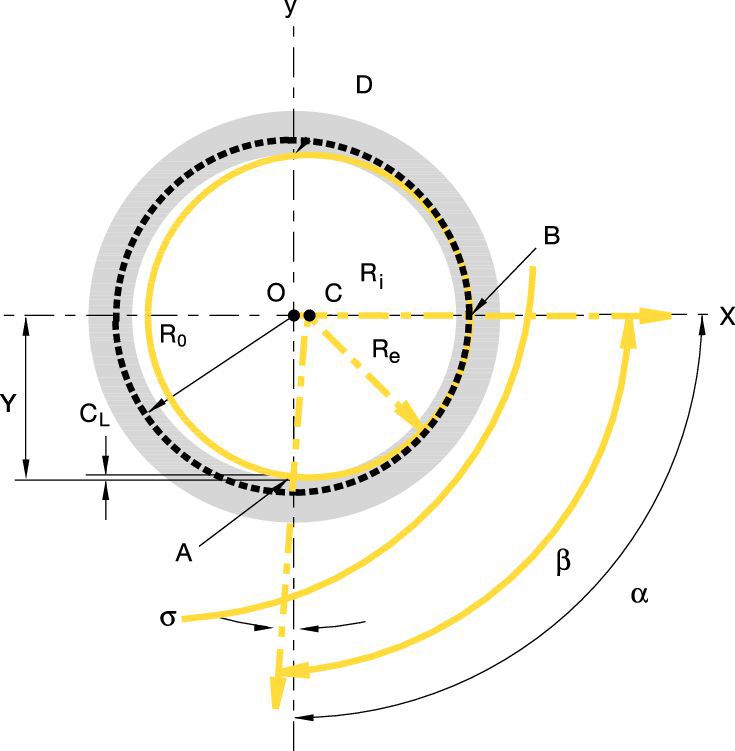 | |||
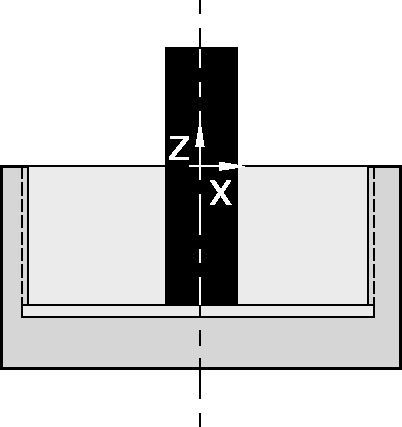 | |||
| Appendix A | |
| Derivation of Formulas for Internal Thread Milling | |
| Re, β, and X can be found by a geometric analysis of the entry path. | |
| This entry path is defined by the tool traveling along a circular path, with a radius of Re about the point C. | |
| R e = | (R i - C L) 2 + R o2 |
| 2R o | |
| Triangle OAC enables us to simply solve for Re. | |
| OA = Ri – CL CA = Re OC = Ro – Re | |
| Pythagoras’ law states: OA2 + OC2 = AC2 | |
| Replacing actual values, we get: | |
| (R i - C L) 2 + (R o - R e) 2 = R e2 | |
| Simplifying, we get: | |
| R e = | (R i - C L) 2 + R o2 |
| 2R 0 | |
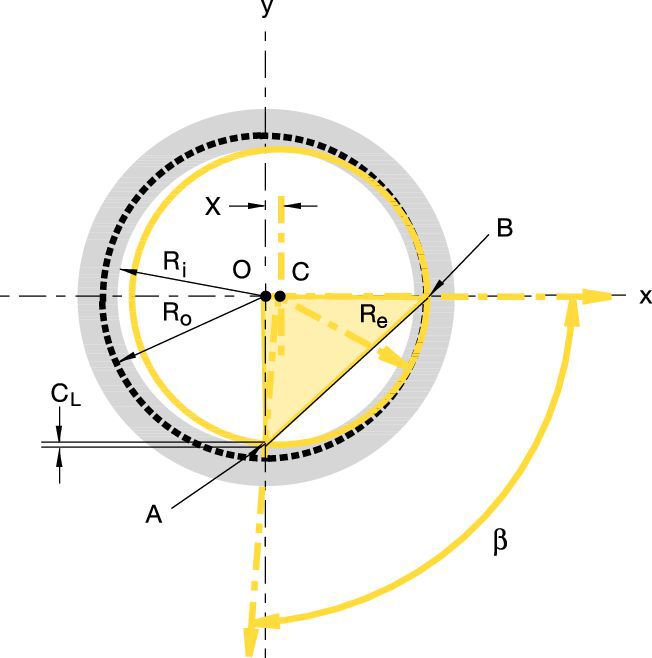 | |
| Find the angle β. | |||
| β can be easily found using the same triangle: | |||
| sin β = | AO | = | (Ro + CL) |
| AC | Re | ||
| β = arc sin | ( | Ro + CL | ) |
| Re | |||
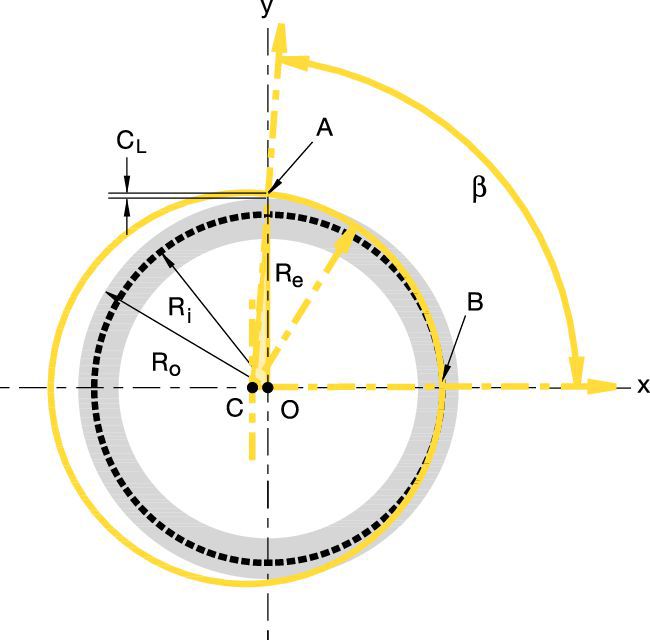 | |||
| Appendix B | |
| Derivation of Formulas for External Thread Milling | |
| Re, β, and X can be found by a geometric analysis of the entry path. | |
| This entry path is defined by the tool traveling along a circular path, with a radius of Re about the point C. | |
| R e = | (R o - C L) 2 + R i2 |
| 2R i | |
| Triangle OAC enables us to simply solve for Re. | |
| OA = Ro – CL CA = Re OC = Re – Ri | |
| Pythagoras’ law states: OA2 + OC2 = AC2 | |
| Replacing actual values, we get: | |
| (R o - C L) 2 + (R e - R i) 2 = R e2 | |
| Simplifying, we get: | |
| R e = | (R o - C L) 2 + R i2 |
| 2R i | |
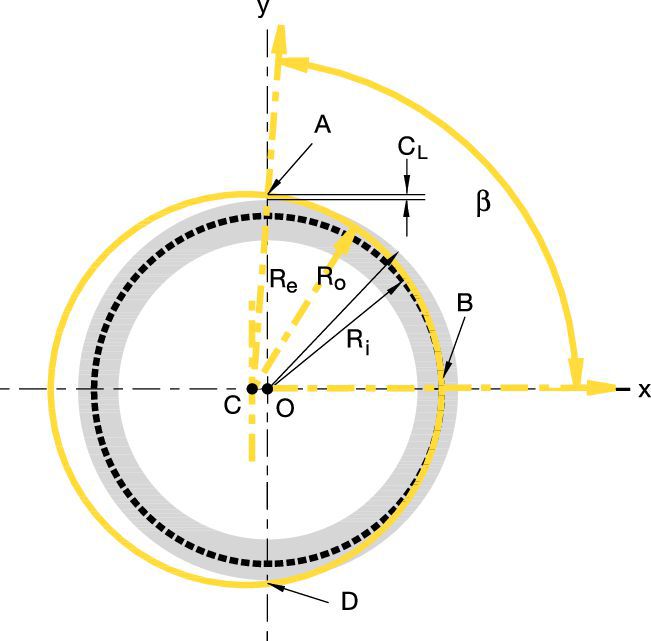 | |
| Find the angle β. | ||||
 | ||||
| sin |  | |||
 | = arc sin | ( | Ro - Re | ) |
| Re | ||||
| Therefore, β = 90° + arc sin | ( | Ro - Re | ) | |
| Re | ||||
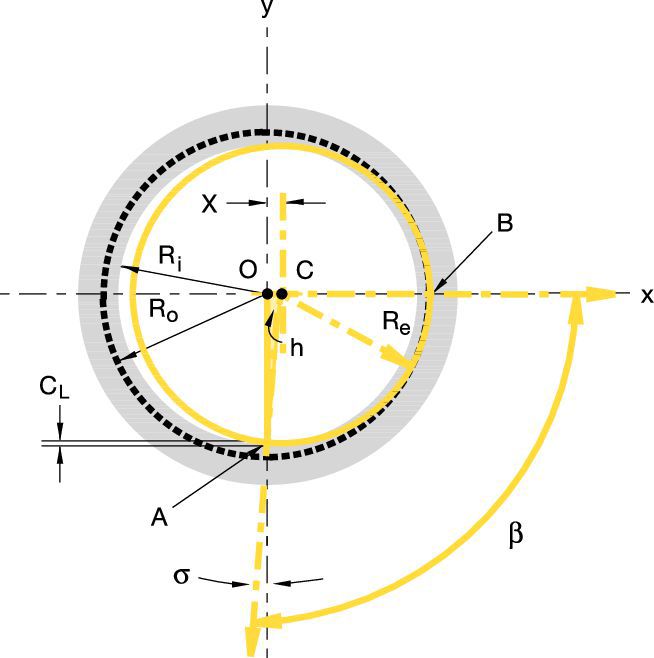 | ||||
| problem | possible cause | solution | |
| excessive insert flank wear | 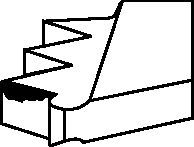 | • Cutting speed too high. | • Reduce cutting speed. |
| • Chip is too thin. | • Increase feed rate. | ||
| • Insufficient coolant. | • Increase coolant quantity/pressure. | ||
| chipping of cutting edge | 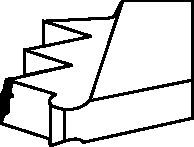 | • Chip is too thick. | • Reduce feed rate. • Use the tangential arc method of entrance. • Increase RPM. |
| • Vibration. | • Check rigidity. | ||
| material build-up on the cutting edge |  | • Cutting speed too slow. | • Increase cutting speed. |
| • Chip thickness too small. | • Increase feed rate. | ||
| chatter/vibration | • Feed rate is too high. | • Reduce the feed. | |
| • Profile is too deep | • Execute two passes, each with increased cutting depth. • Execute two passes, each cutting only half the thread length. | ||
| • Thread length is too long. | • Execute two passes, each cutting only half of the thread length. | ||
| insufficient thread accuracy | • Tool deflection. | • Reduce feed rate. • Execute a zero cut. | |
| thread designation | standard designation | tolerance class |
| UN | ANSI B 1.174 | 2A/2B |
| UNJ | MIL-S-8879A | 3A/3B |
| ISO | R262 (DIN 13) | 6g/6H |
| NPT | USAS B2.1 : 1968 | standard NPT |
| NPTF | ANSI B 1.20.3-1976 | standard |
| BSW | B.S. 84 : 1956, DIN 259, ISO 228/1 : 1982 | medium class A |
| BSPT | B.S. 21 : 1985 | standard BSPT |
| ACME | ANSI B1/5 : 1988 | 3G |
| PG | DIN 40430 | standard |
| TR | DIN 103 | 7e/7H |
I have read and accepted the Terms & Conditions of use

